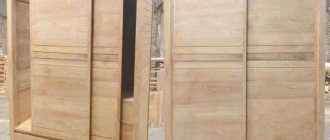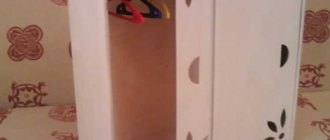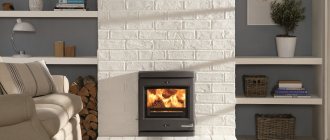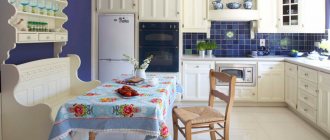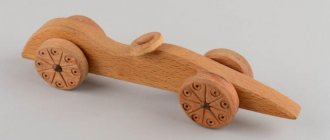Any work with wood is always exciting, because it gives you the opportunity not only to show your own imagination, but also to make something that fully suits your needs and tastes. Agree, it’s nice when there is something made by yourself in the house. If, for example, you worry about how to make a wooden box with your own hands, you can get a useful and beautiful accessory! This box can be used to store collectible coins, jewelry, and other small items. The thing is, in a word, convenient.
How to make a wooden box with your own hands
The idea of beautifully decorating a box with your own hands
The nuances of making wooden boxes
There are various ways to make a wooden box. A simple method, which is most suitable for beginners, involves using a sheet of plywood, which must be carefully leveled and treated against various types of defects. After preparing the surface, it is marked in accordance with the drawing of the future box, which will require a ruler, compass and pencil.
Creative projects do not require a lot of time, complex measurements and planning
On a note! It is important to accurately work out the design of the product, because the quality of the final result will largely depend on this stage.
The most common type of box is classic
To maximize savings on consumables, all elements of the box can be made rectangular - this way there will be almost nothing left over.
After checking the applied markings, the walls, lid and bottom of the structure are cut out. It is important to cut very carefully to obtain the smoothest possible contours. Otherwise, due to negligence, you will have to re-manufacture the damaged parts.
Plywood box
After this, the parts need to be connected. It is best to use wood tenons for connections. If the box is small, the tenons can be ordinary ones with a square cross-section (their height should be the same as the thickness of the plywood sheet).
Tenon joints
If you have cut out all the blanks and removed excess fragments from them with a file, then you can rejoice - the most difficult part of the work is over! Now all that remains is to build a box from ready-made parts. The spikes are driven into the sockets (if necessary, if they do not fit, the excess is filed off with a file). It is recommended to lubricate the walls with glue for greater strength, and then firmly connect them to each other, which is traditionally done using a vice.
Making a wooden box with your own hands
The bottom of the product is placed along the edges with glue, after which it is pressed against the walls and kept for some time. To secure the lid you will need small metal hinges. This is exactly how the simplest wooden boxes are made. Having finished manufacturing, you can begin decorating.
Graceful form, unusual style, modern design
LiveInternetLiveInternet
DIY wooden box. The box is one of the most common products among woodworkers. If you wish, you can make such a box with your own hands.
Planks made of pine, linden, and alder are suitable materials for it; they are easier to process and cut. First, we determine the size and thickness of the walls. As an example, consider a box measuring 10:10:8 cm with a wall thickness of 1 cm. You will need 2 boards 1 cm thick. One 8 cm wide and 40 cm long and the other 10 cm wide and 20 m long. From the long one we cut 4 sidewalls measuring 8 by 10 cm. And from the other, the top and bottom are measuring 10 by 10 cm. To join the sidewalls, mark the thickness for trimming on the inside:
We cut the bevel with a jamb knife at 45 degrees and adjust the joint with sandpaper or on a block. To assemble parts, it is good to use a special device:
The main thing here is that it is rigid and has angles of 90 degrees. After adjusting the sidewalls, glue the parts together using PVA glue. Then glue the bottom and top. We wait a day for gluing and bring the workpiece to an even cube using sandpaper. Then, at a distance of 2 cm from the top, draw a line and carefully saw through each side of the workpiece with a hacksaw:
We polish the resulting parts and chamfer the hinges on the back side of the box so that they sink a little. You can buy ready-made hinges for the box, or you can make it yourself, for example from a metal coffee can:
A thin wire can be used as an axis. We put it in the middle, and bend the loop blank around it, crimp it with pliers. To prevent the lid of the box from moving, we drill small holes in the front wall and lid and insert a dowel into the bottom one:
Now you can decorate the box in different ways: carving, painting, decoupage, burning, etc. as your imagination dictates.
source
Wooden boxes (master class)
My first experience making a wooden box. I am not a master woodcarver and at 29 years old I still haven’t learned how to create carved items. This is why I may disappoint some people, but don’t expect anything extraordinary. I just want to show and tell you how you can make a good box or case, say for glasses, from ordinary 5, 6 mm plywood (I used beech, after all) and without any screws or nails. The idea comes down to gluing 6 parts of the future box together using wood glue. Those. Initially we cut out 4 (if you are making a square one) “walls”, 2 of one size and 2 of another, as well as a bottom and a lid. All this can be cut from one piece of wood, plywood or similar material. So we glue it together and get a hollow box inside without any holes. we process it with sandpaper. Rounding corners and stuff. Now comes the hardest part. It’s better, of course, on a circular saw, but you can try with a jigsaw or even a hacksaw, placing our box “on edge” and sawing it lengthwise. You should know one thing. The higher you lift to the side you have chosen as “top”, the deeper the box itself will be. We saw along the red line (I repeat, it’s up to you to decide where to cut) and we get the base and lid:
Next, you need to decide whether you will hinge the lid or whether it will simply close at the top. In the second option, simply glue slats into the lid on four sides so that the lid fits into the base like a piston. Well, when everything is glued, rubbed and sanded, you can start decorating and painting. How to do this is again up to you, because... You can cover the box with beads or napkins for decoupage. You can use velvet or acrylic paints. Give free rein to your imagination.
Now about the technology - of course, if you are going to make something of a more complex shape, then plywood is not enough. To create these boxes, I used beech planks, pre-cut and processed. The carved edges were made using a hand cutter. For painting I used colored stain. The effect of aging and wear was done like this: First, everything was covered with a light stain, then sanded, then coated again and sanded again. The third time it was coated and sanded again, but this time with a soft sanding sponge. Then the base color is applied on top in several layers, allowing each layer to dry (an hour is enough). And then, using a coarse sanding sponge, the edges, protrusions, and some abrasions are simply applied. It turned out to be something like a ten-year-old box that was actively used. The decoration on the lids is pieces cut out from fittings (this is what the furniture in our homes is covered with) and glued onto the lid. The plates are also wooden, but they are first coated with bronze model paint and then highlighted with gold. So they began to look like metal. With an awl, neatly scribbled, respectively, “Beloved Father-in-Law,” “Beloved Mother-in-Law,” and “My Beloved.” There was also “Beloved Mom,” but I sent this box to her without, unfortunately, having time to photograph it. The handle on the last box was an ordinary plastic one. I sanded it with sandpaper and painted it with bronze model paint. It would have been impossible without her, because... The box is too wide to open by hand. Everything is naturally varnished. I think my experience will be useful to you too.
Samodelkino
Series of messages “Chests and Caskets”:
Part 1 - Baba Yaga’s Box. Part 2 - No title... Part 19 - Carved caskets. Simply a miracle! Part 20 - No title Part 21 - DIY wooden box. Part 22 — Cardboard box. Part 23 - Wedding accessories. ... Part 28 - Boxes embroidered with ribbons. Part 29 — Travel Bag (Quilling + Paper Art). MK Part 30 — Casket. MK
How to decorate a box?
To decorate the product, you can varnish or paint it. Some people prefer carved boxes (such as the one in the photo below) or those made using decoupage technology. In any case, the final result will depend on the creativity and imagination of the master.
Chic vintage box created using decoupage technique
About carved boxes
To perform this type of woodwork, you should prepare:
- oblique knife;
- pencil;
- pen knife;
- compass;
- ruler.
Oblique knife
If you need to cut out oblong-shaped parts, use a feather knife for the job. It is more convenient to cut geometric shapes and straight lines with an oblique knife.
On a note! The required pattern must first be applied to the wood, for which you can use a ruler with a compass or a stencil. If a piece cannot be cut with a knife, then stripping will be required. Having finished cutting, all that remains is to sand the product with sandpaper.
Carved wooden box
Prices for boxes
Casket
Option #1. Beautiful wooden box
Let's start with something simple - with the plywood box mentioned above.
DIY plywood box
To make it, prepare:
- eight-layer plywood;
- router, end mill and 45 degree cutter;
- polymer glue;
- gold paint;
- electric jigsaw;
- acrylic varnish;
- sandpaper;
- gas burner;
- putty;
- screws;
- 2 loops.
Prices for popular models of jigsaws
Jigsaw
Step 1. To begin with, future blanks are marked on a plywood sheet (these are 4 walls, 1 bottom, 1 lid and 4 lid walls).
Marking future blanks
Step 2. All parts are cut out using an electric jigsaw. Although it is better - if possible - to use a circular saw (this way the cuts will be smoother).
Cut blanks
Step 3. The edges of the workpieces are processed with a router at an angle of 45 degrees - this way the layers of plywood will be visible from the outside.
Workpiece edges after processing
Step 4. The surfaces of the workpieces are carefully processed with sandpaper, all flaws are eliminated.
Workpieces are sanded with sandpaper
Step 5. On a flat working surface, a box is created from the walls. It is better to use polymer glue for this - it sets quickly enough and has good viscosity.
Assembling the box with glue
Step 6. The walls of the lid are connected in the same way.
The lid walls are also assembled
Step 7. The walls of the lid are aligned flush with the box until the glue has completely hardened.
Fitting parts
Step 8. The result is the following design, which relatively clearly demonstrates what the box will look like.
This is what the box will look like
Step 9. The joints are puttied. By the way, if a milling table was used (and in our example there was none), then there would be no gaps, since manipulations with small parts would not be carried out by weight.
All cracks are filled with putty
Step 10. The parts are sanded using putty.
Sanding over putty
Step 11. Next, you need to mark the places for attaching the hinges.
Places for hinges are marked
Step 12. Seats are selected using a miter cutter.
Seats selected
Step 13 This is what you should have. You can guess.
Result of work
Step 14. The metal loops are fixed with screws.
Screwing the hinges
Note! Before screwing the hinges, the holes for the screws are made in advance, and with a drill of a slightly smaller diameter! Otherwise, the plywood may tear due to screwing in the screws.
Step 15. The hinges are removed. The product is fired carefully, but it is important not to overheat it (otherwise the walls will move like a screw).
Firing the box
Step 16. The hinges are reinstalled. The lid of the product is coated with acrylic varnish. Then the box is covered with masking tape, as in the photo below, and the edges are painted with a sponge.
Painting the edges with a sponge
Step 17. You can decorate the box with some kind of design. In our example, this is a hieroglyph, pre-printed on paper and cut out (the result is a homemade stencil).
Paper stencils are cut out
Step 18. The stencils are filled, after which you need to wait a while for the drawings to dry.
Stencils are stuffed
Step 19. Actually, that's all. The homemade box is ready!
Photo of the finished plywood box
This is what the box looks like inside
Another photo of the box
Now you can put something in it and put it in the designated place.
The box is in its designated place
We're sure it turned out pretty good
Making a simple box
If the house has all the necessary materials and tools, as well as minimal “communication” skills with the latter, then the work will not create any special difficulties. It is necessary to prepare a suitable piece of plywood (preferably multi-layer). There should be no visible defects - cracks or knots. The list of tools includes:
- pencil, ruler;
- glue (for example, Moment Crystal);
- hand jigsaw;
- hammer;
- sandpaper of different grain sizes;
- file;
- small loops for boxes;
- clamps, vices;
- screws (for example, 2.5x8 mm).
The first stage is constructing a drawing or searching for a suitable diagram in virtual space. For a beginner, it is still more advisable to choose a simple rectangular design, since in its manufacture you can avoid most of the mistakes that a complex geometric shape will certainly provoke.
Case manufacturing
First, the body parts are transferred to a plywood sheet. Using a pencil and a ruler, draw 4 walls on it - two long frontal and two short side. Grooves are marked at the edges of the ends of the elements; their height is equal to the thickness of the plywood sheet. This connection will make the box more reliable, similar to store-bought items. Then they draw the bottom, which should be located inside the walls, at the same level (flush) with their bottom.
All drawn elements are carefully cut out with a jigsaw. After the blanks are made, all ends are carefully sanded with sandpaper. Then the inner walls of the box and the upper surface of the bottom are treated in the same way, otherwise it will be much more difficult to do this later.
The walls are glued together, having previously coated the spiked ends with the compound. They are driven into the sockets; if necessary, they are ground down a little with a file. Lastly, attach the bottom. If it refuses to fit inside the walls, it is ground (grinded) again until the base can “sit” tightly in its rightful place. Then the semi-finished product is placed in clamps (vices).
Construction of the cover
It can be made flat, but such a thing will immediately lose a considerable amount of originality. Therefore, the lid is made in the same way as the body. First, the large part is cut out, then the small side walls with grooves. All workpieces are also sanded: first the walls on the inside, then the lid; it can be processed on both sides at once.
After gluing the parts, the lid is also placed in clamps. After both parts of the box have dried, they are connected using hinges and mini-screws. The holes for them are made in advance; their diameter is slightly smaller than that of the fasteners. If you forget about this condition, the plywood may tear.
Wooden boxes are made in almost the same way - from boards, but in this case more serious tools are needed. For high-quality cutting, a circular and miter saw is used; shaped edges are obtained using a router.
Option #2. Original double-walled box
Making such a box is much more difficult, but we will help you figure it out.
Double-walled cherry box
Step 1. On the pre-processed workpiece, you need to draw cut lines with a pencil. And here one important point should be taken into account: when transferring the sketch, it is imperative that the longitudinal orientation of the fibers be observed!
Drawing of a cherry box
Step 2. An even longitudinal part is cut from the workpiece (its thickness should be 1.5-2 cm). This part will serve as the cover of the product in the future.
Sawing the workpiece
Step 3. Next, change the inclination of the saw table. It is necessary to change the angle literally by a few degrees.
Changing the inclination of the saw table
Step 4. After this, the part is cut into 2 parts and the internal waste part is cut out. Thus, a conical cavity of the product is formed.
Cutting out internal waste
Step 5. The halves are glued back together. Thanks to this, by the way, internal stress is also relieved and cracking and deformation of the product are prevented. The glue should be applied in a thin layer, and all excess inside should be carefully removed.
The two halves are glued back together
Step 6. The glued parts are placed under the clamps. In this case, you need to carefully ensure that there are no distortions or displacements.
The glued workpiece is carefully placed under the clamps
Step 7. The table returns to the horizontal position, a couple of slices are cut from the waste part. This will be the bottom and cover of the future product.
Drawing of the blank for the lid and bottom
Sawing blanks
Step 8. The interior of the box is painted. It is more convenient to carry out painting at this stage, while there is free access from both sides.
Cavity painting
Step 9. The table returns to the inclined position, after which cuts are made along the outer contour.
Step 10. A thin layer of glue is applied to the ends of the bottom, then it is inserted into the lower part of the product (you need to press it with your fingers until it stops).
Bottom gluing
Step 11. The lid elements are glued to the workpiece, cut off at the initial stages of work.
Cover stopper
Step 12. When the glue has dried, the main outline of the lid is outlined, after which this part is cut out.
Sawing the lid
Finished lid for the box
Note! The technique described above is universal, because it makes it possible to experiment with shapes and designs, making original and beautiful boxes with your own hands.
Bottom
Next, we will consider the production of the bottom to make a wooden box.
- To mill blind tongues for bottom C (3x133x279 - 1 piece) in end walls A, insert a straight groove cutter d=3 into the collet of the router and adjust it to a milling depth of 5 mm.
Note. The bottom can be made from sanded plywood 3 mm thick. If there is no plywood, then you can plan the board.
- Secure the longitudinal stop at a distance of 8 mm from the cutter. Place masking tape on it and place a mark for the start of milling at a distance of 6 mm to the left of the cutter and an end mark at a distance of 6 mm to the right of the cutter.
- Using double-sided tape, glue the handles from the scraps to the outer sides of the end walls, press the bottom edges against the longitudinal stop and rout blind tongues on the inside of both parts, as shown in the top and bottom pictures. Without changing the settings, mill through the tongues on the inside of the longitudinal walls B.
- Then finally grind the end walls A and longitudinal walls B, making chamfers 1.5-2.0 mm wide at the ends of the tenons.
- Apply glue evenly into the cutouts between the tenons and into the tongues of the end and longitudinal walls. Insert the bottom into the tongues, assemble the structure and secure it with clamps, controlling the squareness of the frame assembly.
- How to make a box out of wood without making compartments in it. Let's make a partition D - 6x43x124 - 1 pc. Sand it and glue it using wood glue in the middle, clamp it with a clamp.
Option #3. Simple walnut box
The same steps must be followed when making another project - a wooden box with four walls. Having an unusual design and curved shape, such a box will look really modern and stylish!
Simple walnut box
Drawing of a walnut box
Stages of making a box
Prices for clamping elements
Clamps
This box turned out to be walnut
Option number 4. Product with concave lid
Drawing of a box with a concave lid
Casket with concave lid
Making a simple box
Sawing a curved lid
Finishing the lid
Option #5. Ice cream stick box
Ice cream stick box
To make such a box suitable for storing various small items, prepare:
- ice cream sticks (29 pieces);
- scissors;
- acrylic paints (2 colors required);
- ruler;
- corrugated cardboard;
- pencil;
- satin ribbon;
- hot glue.
Step 1. To begin, the sticks are painted in 2 colors (choose them yourself). Since our number is odd, it is divisible by 15 and 14.
A total of 29 sticks were used
Painting sticks
Step 2. A pair of rectangles (70x55 mm) and a pair of semicircles (height - 30 mm, base - 70 mm) are cut out of corrugated cardboard, after which the cut out parts are painted.
Corrugated cardboard blanks
Step 3. For the bottom, 7 sticks are used, laid out in alternating colors. To prevent the sticks from moving, you can temporarily fix them in the center with tape.
7 sticks on the bottom
Step 4. Cardboard rectangles are glued to the sides.
Gluing the sides
Prices for gun adhesives
Glue gun
Sidewalls are glued
Step 5. Next, sticks are glued along the edges (also with alternating colors, 6 pieces per side).
Glue 6 sticks on each side
Step 6. Another 10 sticks are glued onto the semicircles - the result is the lid of the future box.
10 sticks per lid
That's it, now you can see exactly what the product will look like.
The box is almost finished
Step 7. Strips are cut out from satin ribbon. Next, the ends of the cardboard are sealed with these strips.
Cutting strips
Sealing the ends of the cardboard
Step 8. A couple of pieces of tape are glued to the lid of the product, but in such a way that the edges hang down on one side by about 20 mm. These hanging edges are glued to the box, resulting in a kind of “loops” through which the lid will open.
Pieces of tape are glued to the lid
Cover fastening
Step 8. Additionally, a bow (made from the same satin) and a bead are glued. That's it, our beautiful box is ready! And if you have any other questions, check out the video below.
Finished box made from ice cream sticks
Video – Decorative box made from popsicle sticks
Making a decorative box
Drawing and cutting
To make a beautiful box, first of all, we will need fairly detailed drawings: we will describe how to make a box from plywood below, but you will have to decide on its appearance and dimensions yourself:
- First, we select a design, which we then transfer to a sheet of paper in the form of a sketch.
- We indicate the estimated dimensions on the sketch. To avoid unpleasant surprises, experts recommend folding a simple paper layout. This way you will know for sure that the product will “fit” into its intended place, and will not be too big or too small.
- If the dimensions satisfy us, we draw a drawing of a plywood box on graph paper.
- Based on the drawing, we form a cutting sheet, arranging the details of our future box on the workpiece as compactly as possible. This can be done using paper templates, but it will be easier to use a special computer program.
- Using the cutting sheet, we cut out the walls, bottom and lid of the box from the blank. This can be done either independently or in a company that specializes in cutting fiberboard, chipboard and similar materials. True, not all companies will undertake such minor work, and the price of the product in this case will increase.
Product processing and assembly
Once we have the required number of blanks cut to size, we can begin creating the box itself:
- We process the cut plywood strips with sandpaper. We pay special attention to cleaning the edges.
- We apply the printed templates to the blanks and transfer the drawings to the plywood base for cutting.
- For through cuts, we drill starting holes with a drill, and then cut out the pattern using a jigsaw.
- We additionally process the openwork parts with files and sandpaper, removing splinters and chamfering.
Note! These recommendations should be taken into account only if the drawings of plywood boxes used suggest the presence of openwork elements. If the walls and lid remain intact, you can immediately proceed to assembly.
When the preparatory work is completed, we begin to assemble the box:
- First, we fasten the side walls together. The most reliable will be an adhesive connection, reinforced with furniture nails or staplers.
- Then we attach the bottom to the frame.
- We fix the metal hinges in the upper part using self-tapping screws. We hang a lid on them (flat or assembled in the form of a box).
Finishing
Before us is an almost finished box, which, however, needs to be slightly modified. Here the instructions largely depend on what we want to get in the end:
- We re-process all surfaces and corners with sandpaper, removing all burrs formed during the installation process.
- We putty the joints of the plywood sheets and the fastening points, hiding all the irregularities. We grind the dried putty, achieving a perfectly smooth surface.
- We apply a layer of primer to all external surfaces, which will ensure reliable adhesion of the wood to the varnish coating.
- We carry out varnishing by applying varnish in several layers. If a varnish mixture with pigments is used, then we place a darker varnish on the base layers, and cover the surface with an almost transparent one.
- An alternative to varnishing can be painting the box with special paints for wood.
Advice! To improve the appearance, a decorative component - craquelure - is sometimes added to the paint. When drying, it creates a network of microcracks on the painted layer, thereby simulating the effect of aging.
- Another way to traditionally decorate plywood boxes is decoupage. This technology consists of covering the workpiece with decorative napkins and then varnishing it.
- To complete all the work, we attach fittings to the surfaces: handles, latches, etc.
The inner surface must be treated separately. The easiest way is to sand all the irregularities and coat the plywood with varnish. But you can also work hard by finishing the “insides” with fabric: of course, this is not an easy task, but the box will also look much more attractive!
Similar materials
The box is one of the most common products among wood craftsmen. The boxes offer many design options, which is why they are most often used as original interior elements. You can buy a ready-made product or make it yourself. Making a plywood box is a fairly simple task if you have patience and get creative. Such products can be excellent gifts for friends and loved ones. In this article we will look at how to make a plywood box with your own hands.
Decorating a wooden box – what is worth knowing?
Despite the attractive design and shape, the box will look truly original only after decoration. The technique of relief carving provides in this case almost limitless scope for creativity.
You can decorate the box in different ways
Using key carving techniques, you can create original textures on the box. We can talk about both simple textures and complex ornaments or geometric shapes.
Chisels for applying relief
- A semicircular chisel used to texture the product with small dimples.
- Forming grooves with an angled chisel on the surface of the box lid.
On a note! In the photo below you can find more complex examples of decoration that use complex textures and geometric patterns.
Options for decorating boxes
A few more decoration options
The benefits of shopping on papacarloo.ru
Buy carved boxes on favorable terms in the online store. Products from a manufacturer with extensive experience and a wide range of products are presented. The advantages of the trading platform are:
- reasonable prices without markups;
- variety of boxes in shape, size, purpose, design and design;
- prompt courier delivery to different regions of the Russian Federation;
- possibility of self-pickup from 7,000 pick-up points;
- the most favorable terms of cooperation for wholesale customers;
- guarantee of safety and high quality of products.
The boxes are sent to customers in special plastic packaging with decorative tape, which increases their attractiveness and protects them from dirt and damage in transit.
